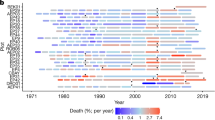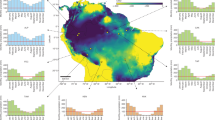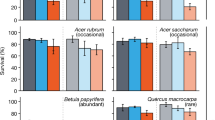Abstract
Drought and heat-induced tree mortality is accelerating in many forest biomes as a consequence of a warming climate, resulting in a threat to global forests unlike any in recorded history1,2,3,4,5,6,7,8,9,10,11,12. Forests store the majority of terrestrial carbon, thus their loss may have significant and sustained impacts on the global carbon cycle11,12. We use a hydraulic corollary to Darcy’s law, a core principle of vascular plant physiology13, to predict characteristics of plants that will survive and die during drought under warmer future climates. Plants that are tall with isohydric stomatal regulation, low hydraulic conductance, and high leaf area are most likely to die from future drought stress. Thus, tall trees of old-growth forests are at the greatest risk of loss, which has ominous implications for terrestrial carbon storage. This application of Darcy’s law indicates today’s forests generally should be replaced by shorter and more xeric plants, owing to future warmer droughts and associated wildfires and pest attacks. The Darcy’s corollary also provides a simple, robust framework for informing forest management interventions needed to promote the survival of current forests. Given the robustness of Darcy’s law for predictions of vascular plant function, we conclude with high certainty that today’s forests are going to be subject to continued increases in mortality rates that will result in substantial reorganization of their structure and carbon storage.
This is a preview of subscription content, access via your institution
Access options
Subscribe to this journal
Receive 12 print issues and online access
$209.00 per year
only $17.42 per issue
Buy this article
- Purchase on Springer Link
- Instant access to full article PDF
Prices may be subject to local taxes which are calculated during checkout



Similar content being viewed by others
References
Van Mantgem, P. J. et al. Widespread increase of tree mortality rates in the western United States. Science 323, 521–524 (2009).
Peng, S. et al. A drought-induced pervasive increase in tree mortality across Canada’s boreal forest. Nature Clim. Change 1, 467–471 (2011).
Settele, J. et al. in Climate Change 2014: Impacts, Adaptation and Vulnerability (eds Field, C. et al.) Ch. 4 (IPCC, Cambridge Univ. Press, 2014)
Hicke, J. A. et al. Effects of biotic disturbances on forest carbon cycling in the United States and Canada. Glob. Change Biol. 18, 7–34 (2012).
Phillips, O. L. et al. Drought sensitivity of the Amazon rainforest. Science 323, 1344–1347 (2009).
Williams, A. P. et al. Temperature as a potent driver of regional forest drought stress and tree mortality. Nature Clim. Change 3, 292–297 (2013).
Carnicer, J. et al. Widespread crown condition decline, food web disruption, and amplified tree mortality with increased climate change-type drought. Proc. Natl Acad. Sci. USA 108, 1474–1478 (2011).
Matusick, G. et al. Sudden forest canopy collapse corresponding with extreme drought and heat in a mediterranean-type eucalypt forest in southwestern Australia. Eur. J. Forest Res. 132, 497–510 (2013).
Allen, C. D. et al. A global overview of drought and heat-induced tree mortality reveals emerging climate change risks for forests. Forest Ecol. Manag. 259, 660–684 (2010).
Jiang, X. et al. 2013. Projected future changes in vegetation in western North America in the 21st century. J. Clim. 26, 3671–3687 (2013).
Reichstein, M. et al. Climate extremes and the carbon cycle. Nature 500, 287–295 (2013).
IPCC Climate Change 2013: The Physical Science Basis (eds Stocker, T. F. et al.) (Cambridge Univ. Press, 2013).
Whitehead, D. & Jarvis, P. G. in Water Deficits and Plant Growth Vol. 6 (ed Kozlowski, T. T.) 49–152 (Academic Press, 1981).
Mencuccini, M. The ecological significance of long-distance water transport: Short-term regulation, long-term acclimation and the hydraulic costs of stature across plant life forms. Plant Cell Environ. 26, 163–182 (2003).
Choat, B. et al. Global convergence in the vulnerability of forests to drought. Nature 491, 752–755 (2012).
Lefsky, M. A. A global forest canopy height map from the Moderate Resolution Imaging Spectroradiometer and the Geoscience Laser Altimeter System. Geophys. Res. Lett. 37, L15401 (2010).
Suarez, M. L. & Kitzberger, T. K. Recruitment patterns following a severe drought: Long-term compositional shifts in Patagonian forests. Can. J. Forest Res. 38, 3002–3010 (2008).
Agee, J. K. Fire Ecology of Pacific Northwest Forests (Island Press, 1996).
Westerling, A. L., Turner, M. G., Smithwick, E. A. H., Romme, W. H. & Ryan, M. G. Continued warming could transform Greater Yellowstone fire regimes by mid-21st Century. Proc. Natl Acad. Sci. USA 32, 13165–13170 (2011).
Cullingham, C. I. et al. Mountain pine beetle host-range expansion threatens the boreal forest. Mol. Ecol. 20, 2157–2171 (2011).
Williams, A. P., Xu, C. & McDowell, N. G. Who’s the new sheriff in town regulating boreal forest growth? Environ. Res. Lett. 6, 041004 (2011).
McDowell, N. G., Adams, H. D., Bailey, J. D., Hess, M. & Kolb, T. E. Homeostatic maintenance of ponderosa pine gas exchange in response to stand density changes. Ecol. Appl. 16, 1164–1182 (2007).
McDowell, N. G. et al. Interdependence of mechanisms underlying climate-driven vegetation mortality. Trends Ecol. Evol. 26, 523–532 (2011).
McDowell, N. G., Adams, H. D., Bailey, J. D. & Kolb, T. E. The response of ponderosa pine growth efficiency and leaf area index to a forty-year stand density experiment. Can. J. Forest Res. 37, 343–355 (2007).
Stephens, S. L. et al. Managing forests and fire in changing climates. Science 342, 41–42 (2014).
Swetnam, T. W., Allen, C. D. & Betancourt, J. L. Applied historical ecology: Using the past to manage for the future. Ecol. Appl. 9, 1189–1206 (1999).
Brando, P. M. et al. Abrupt increases in Amazonian tree mortality due to drought–fire interactions. Proc. Natl Acad. Sci. USA 111, 6347–6352 (2014).
Grady, K. C. et al. Genetic variation in productivity of foundation riparian species at the edge of their distribution: Implications for restoration and assisted migration in a warming climate. Glob. Change Biol. 17, 3724–3735 (2011).
Lloret, F. et al. Extreme climatic events and vegetation: The role of stabilizing processes. Glob. Change Biol. 18, 797–805 (2012).
Acknowledgements
The writing of this manuscript was supported by a European Union grant EUFORINNO, the US Department of Energy’s Office of Science, and the Ecosystems and Climate-Land Use programs of the US Geological Survey.
Author information
Authors and Affiliations
Contributions
N.G.M. developed the theory, conducted analyses and wrote the manuscript. C.D.A. provided supportive data and co-wrote the manuscript.
Corresponding author
Ethics declarations
Competing interests
The authors declare no competing financial interests.
Supplementary information
Rights and permissions
About this article
Cite this article
McDowell, N., Allen, C. Darcy's law predicts widespread forest mortality under climate warming. Nature Clim Change 5, 669–672 (2015). https://doi.org/10.1038/nclimate2641
Received:
Accepted:
Published:
Issue Date:
DOI: https://doi.org/10.1038/nclimate2641
This article is cited by
-
Recent increase in tree damage and mortality and their spatial dependence on drought intensity in Mediterranean forests
Landscape Ecology (2024)
-
Climate-driven range shifts of Levaillant’s Woodpecker Picus vaillantii in the Western Mediterranean
Regional Environmental Change (2024)
-
Tree hydrological niche acclimation through ontogeny in a seasonal Amazon forest
Plant Ecology (2023)
-
Global field observations of tree die-off reveal hotter-drought fingerprint for Earth’s forests
Nature Communications (2022)
-
Widespread shift from ecosystem energy to water limitation with climate change
Nature Climate Change (2022)



